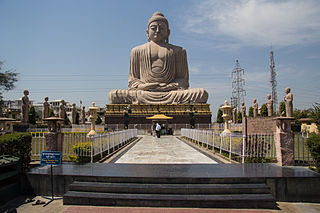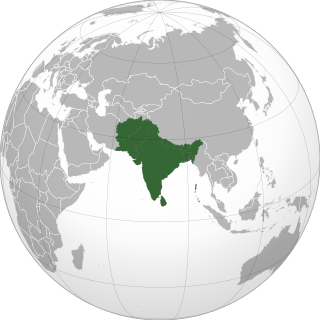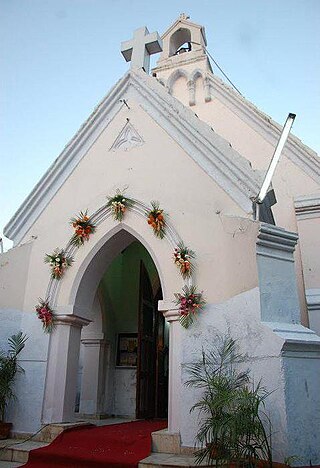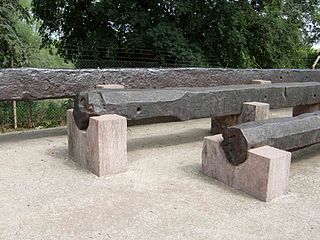
The pillars of Ashoka are a series of monolithic columns dispersed throughout the Indian subcontinent, erected—or at least inscribed with edicts—by the 3rd Mauryan Emperor Ashoka the Great, who reigned from c. 268 to 232 BC. Ashoka used the expression Dhaṃma thaṃbhā, i.e. "pillars of the Dharma" to describe his own pillars. These pillars constitute important monuments of the architecture of India, most of them exhibiting the characteristic Mauryan polish. Twenty of the pillars erected by Ashoka still survive, including those with inscriptions of his edicts. Only a few with animal capitals survive of which seven complete specimens are known. Two pillars were relocated by Firuz Shah Tughlaq to Delhi. Several pillars were relocated later by Mughal Empire rulers, the animal capitals being removed. Averaging between 12 and 15 m in height, and weighing up to 50 tons each, the pillars were dragged, sometimes hundreds of miles, to where they were erected.

James Prinsep FRS was an English scholar, orientalist and antiquary. He was the founding editor of the Journal of the Asiatic Society of Bengal and is best remembered for deciphering the Kharosthi and Brahmi scripts of ancient India. He studied, documented and illustrated many aspects of numismatics, metallurgy, meteorology apart from pursuing his career in India as an assay master at the mint in Benares.

Fatehabad district is one of the twenty two districts of the state of Haryana, India. Fatehabad was founded by Firuz Shah Tughlaq. Fatehabad district was carved out of Hisar district on 15 July 1997.

In religion and spirituality, a pilgrimage is a long journey or search of great moral significance. Sometimes, it is a journey to a sacred place or to a shrine of importance to a person's beliefs and faith. Members of every major religion participate in pilgrimages. A person who makes such a journey is called a pilgrim.
Fatehabad is a town and a municipal council in Fatehabad district in the state of Haryana, India. It is the administrative headquarters of Fatehabad district.

Haryana is a state in India. The state houses several sites from the Indus Valley Civilization, which was a cradle of civilization. In the Mahabharata, Haryana is mentioned as Bahudanayak Region.

The Kos Minars are medieval Indian milestones along the Grand Trunk Road in northern Indian subcontinent, that were introduced by the 16th-century Pashtun ruler Sher Shah Suri. Kos Minars were erected to serve as markers of distance along royal routes from Agra to Ajmer, Agra to Lahore, and from Agra to Mandu in the south.

The Ashokan edicts in Delhi are a series of edicts on the teachings of Buddha created by Ashoka, the Mauryan Emperor who ruled in the Indian subcontinent during the 3rd century BC. The Edicts of Ashoka were either carved on in-situ rocks or engraved on pillars erected throughout the empire; examples of both are found in Delhi.

The Feroz Shah Kotla or Kotla was a fortress built circa 1354 by Feroz Shah Tughlaq to house his version of Delhi city called Firozabad.

Firoz Shah palace complex (Hisar-e-Firoza) is an archaeological complex located in modern-day Hisar, in the Haryana state of India, built by Firoz Shah Tughlaq of the Delhi Sultanate in 1354 AD. It is maintained by the Archaeological Survey of India.

St. Thomas' Church is located in Hisar city of Haryana, India. It is located in central part of Hisar near railway station. It has been declared as a historical monument by Indian National Trust for Art and Cultural Heritage. The Church is dedicated to St. Thomas, one of the 12 main disciples of Jesus Christ.
Tourism in Haryana relates to tourism in the state of Haryana, India. There are 21 tourism hubs created by Haryana Tourism Corporation (HTC), which are located in Ambala, Bhiwani Faridabad, Fatehabad, Gurgaon, Hisar, Jhajjar, Jind, Kaithal, Karnal, Kurukshetra, Panchkula, Sirsa, Sonipat, Panipat, Rewari, Rohtak, Yamunanagar, Palwal and Mahendergarh.

The Dhar iron pillar is a now-fragmented iron column located in the Dhar town of Madhya Pradesh, India. The exact origins of the pillar are unknown, but according to the local tradition, it was a victory column erected by the 11th century Paramara king Bhoja.

The 48 kos parikrama is a parikrama of various Mahabharata-related and other Vedic-era tirthas around the holy city of Kurukshetra in the state of Haryana, India.
Topra, combined name for the larger Topra Kalan and adjacent smaller Topra Khurd, is a Mauryan Empire-era village in Yamunanagar district of Haryana state in India. It lies 14 km west of Yamunanagar, 14 km from Radaur and 90 km from Chandigarh.

Jama Masjid is a historic mosque in Mandu in the Central Indian state of Madhya Pradesh. Built in Mughal style of architecture, the mosque has been believed to have been built during the reign of Hoshang Shah and completed during the reign of Mahmud Khilji in 1454.

The Major Pillar Edicts of Indian Emperor Ashoka refer to seven separate major Edicts of Ashoka inscribed on columns, the Pillars of Ashoka, which are significantly detailed and are among the earliest dated inscriptions of any Indian monarch. An English translation of the Edicts was published by Romila Thapar.
Feroz Khan built the Sarai in 1637 AD during the reign of Mughal emperor Shah Jahan; hence it was named after the Mughals. Before the first battle of Panipat, Babur camped at Gharaunda. Now, there are two existing gateways in the area. They exist within a distance of about 100 meters from each other. The Sarai has a quadrangular shape, with cells on all four sides. Existing gateways form a part of the Northern and Southern walls, and both of them have three stories. The gateways are made of ‘Lakhauri’ bricks and decorated with panels, balconies, rounded towers, and angular flutes.

The Delhi-Topra pillar is one of the pillars of Ashoka, inscribed with the moral edicts promulgated by Ashoka, the Mauryan Emperor who ruled in the Indian subcontinent during the 3rd century BCE. The Edicts of Ashoka were either carved on in-situ rocks or engraved on pillars erected throughout the empire. The pillar, originally erected in Topra Kalan, was transferred to Delhi in the 14th century by Feroz Shah Tughlaq.














